After releasing their POD X3 and X3 Live in 2008, worthy descendants in their own right of the Pod XT, Line 6 felt it necessary to update the POD Pro. So, it's no surprise they’ve come up with a POD in rack format, offering a plethora of inputs and outputs, called the POD X3 Pro.
The idea behind the Pod Pro was to feature numerous inputs and outputs (analog and digital), to satisfy the most demanding user, either on stage or in the studio. Its rack format makes it easier to integrate it into a studio and therefore it could more easily find its place within professional situations. Though the size of the original POD makes it easier to transport for a guitarist, it’s more complicated to fit it in front of a console, for one thing. The same applies to the Pod Live, which is aimed primarily at guitarists who often play live and want to have the controls of their sound at their feet.
So the POD X3 Pro has the same concept as the X3 and X3 Live versions: it features Line 6’s famous modeling (78 guitar amps, 24 guitar speakers, 98 effects, 28 bass amps, 22 bass speakers, 6 mic preamps and 4 positionnable microphones) and its software, POD Farm, lets you record, edit presets more easily with a nice graphic interface, and re-amp the sound after.
But first let’s take a look at what interests us most: its controls and inputs/outputs!
Front Panel
 |
First you’ll notice a change in the Pod’s look: much of that “Line6 red” that the brand is known for, has now become dark gray. Only the two guitar and microphone preamp inputs are still in red, and stand out from the rest of the device. Personally, I find this rack uglier than the Pod Pro XT and its general appearance seems cheaper, which, for a “Pro” level product doesn’t bode well. The knobs look the same as for the rest of the Line6 range. The big LCD screen is the same as the one on the Pod X3, and so much the better, since it can display a lot of information and makes the interface easier to understand. One last change in its look: the Pod Pro has grown, it’s now 3U high.
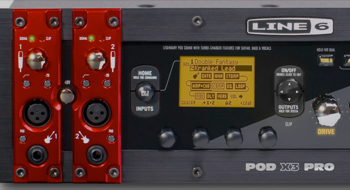 |
On the left are the two XLR mic inputs and the two guitar/instrument inputs (jack 1/4"). On each red strip there are two LEDs: a green one to show there’s a signal and a red one indicating that the input signal is clipping. There’s a low-cut filter, a-20dB PAD for the microphone and another PAD for the guitar. Finally, there’s a switch to activate the general 48V phantom power in the middle of the two red strips.
As for navigating, it’s the same as other POD X3 models: the screen displays either the signal path ( “Home”) or edit parameters ( “Edit”). The Home button provides access to presets or lets you change a setting (on the Edit page). Coupled with four buttons and four multi-function knobs, the navigation system of the Pod X3 Pro is very easy to get used to and much more convenient than the Pod XT, thanks to its large backlit LCD screen which displays a lot of information.
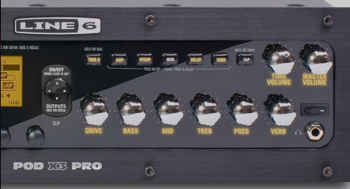 |
Other buttons facilitate access to certain important pages: Inputs lets you, of course, display the input configuration, Outputs, you probably guessed it, shows the output settings, Tone 2 lets you change channels or activate both at the same time (a new feature of the X3 series, more on that later). The other buttons and knobs are rather standard fare and won’t surprise guitarists used to handling amps. These knobs are: volume, bass, mid, treble, drive, presence, reverb, and buttons to jump to a certain module: amp, stomp (distortion pedal), delay, and reverb. The “Tap” button adjusts delay speed and/or activates the integrated tuner.
Even though the Pod X3 Pro probably won’t win any fashion or design awards, it’s a winner when it come to work flow (ergonomics) and its navigation system is probably the thing that has evolved the most in this new generation POD.
Back Panel
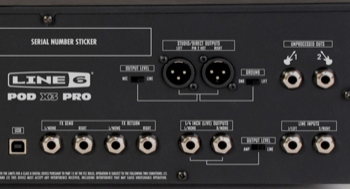 |
Looking at the back panel you’ll understand a little better why they call it “Pro”. With all its inputs and outputs, it will definitely satisfy most users, whether in the studio, at home, or on stage. First off, there’s the unavoidable USB slot which lets you modify preset settings and record with your computer. Because it’s Line 6 there’s also the famous Variax interface with which, if you’re the lucky owner of this modeling guitar, you can directly control its sound via the Pod X3 Pro. This feature is convenient on stage or in the studio: imagine loading presets of your POD and your Variax in a single click or pedal stomp: great! Speaking of pedals, you can plug in any one of Line 6’s pedals or multi-effects via the RJ45 input, which will no doubt please those who take their Pod with them when going on stage. In terms of digital inputs/outputs, the POD X3 Pro has XLR AES/EBU and S/PDIF coaxial. Below that there are the MIDI in/out (for Program Changes for selecting presets) and to the right of that, a bunch of analog inputs and outputs…
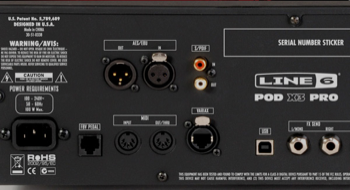 |
On this point, the people at Line 6 have pulled all the stops. First let’s start with the XLR outputs complete with an output level switch (line or microphone) and a “ground lift ” switch in case of a ground loop. Add to that a pair of FX sends and a pair of FX returns (1/4" Jack) for the effects loop, another pair of unbalanced (-10dBV) outs (1/4" Jack) that are line level or “amp” (to bypass the speaker simulation and go directly to your guitar amp) and a pair of unbalanced line-level inputs (1/4" Jack) to connect another source to the POD. Finally, the icing on the cake, the Pod X3 Pro has two unbalanced instrument outs (1/4" Jack) to recover the unprocessed signal from your guitar, taken directly from the POD guitar input: handy for re-amping!
Speaking of re-amping, one of the main innovations of the X3 series is that it features two programs that prove to be very useful for just this purpose…
Software Bundle
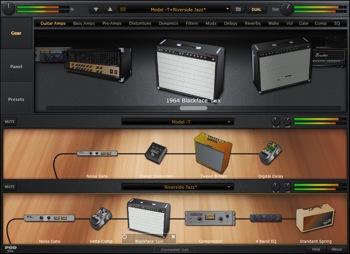 |
On the POD box you’ll see a sticker saying “POD Farm plug-in included”. What’s that? Nothing more nor less than a software version of the POD X3 (in the form of a plug-in). You can therefore have multi-instances and re-amping galore. Since the USB interface offers both the processed and unprocessed sound of your guitar, it’s possible to keep the unprocessed sound on the side and then process it afterwards using the POD Farm plug-in. This “detail” greatly enhances the POD’s utility for any home studio owner working with a sequencer. To top it off, POD Farm offers a new graphic interface that’s very well thought out and a model of ergonomics and work-flow. Note that this small wonder is free for all POD X3 and platinum version owners. All the “models” in your POD are also contained in POD Farm. Gearbox is also still available and remains quite useful for tweaking, loading, and saving presets with a GUI that’s more convenient than that of the POD.
When connected to your computer (USB), the POD X3 Pro also serves as a digital audio interface with 8 outputs available via USB. Outputs 1 and 2: send the main processed signal (Tone 1, Tone 2 or Tone 1 + 2), outputs 3 and 4: Tone 1 separately in stereo, outputs 5 and 6: Tone 2 separately in stereo, output 7: the sum of the inputs chosen for Tone 1, and output 8: the sum of the inputs chosen for Tone 2. The latter two will therefore be used for re-amping via the POD Farm plug-in or any other plug-in for that matter!
The bundled software is a success, but what about the device itself?
Dual Tone
 |
The novelty of the X3 series is the Dual Tone feature which allows two completely independent tone paths (Tone 1 and 2). The sky’s the limit, or almost. You can connect two guitars and have two completely different settings (amplifiers, effects, etc..) for each, but you can also send the signal of a single guitar into both circuits and get from both outputs two different and/or complementary sounds. The internal routing of the POD X3 Pro is very flexible and lets you send any input to any tone path. Finally, you can quickly switch between the two tones, without any gap or break in the sound. These seamless transitions between the two tones include delay and reverb tails! You can already imagine the numerous possibilities: recording a bass (the POD now has bass amp simulations) and a guitar at the same time, or even a vocal (via its mic preamp simulations) and a guitar… In short, we’re dealing with a genuine audio Swiss Army knife that you can take on stage with you (via an optional pedal) or into your home studio.
As for its sound, Line6 features more and more models and it’s becoming difficult not to find something you like in this plethora of sounds. The list available on this page makes your head spin. Not all are memorable, some are even more of a joke. But in general, its clean sounds are very realistic and most of the distortion sounds may fool you in the mix at least. Since I don’t have the original versions of all the simulated amplifiers (unfortunately), it’s difficult to judge the fidelity of all the simulations. Some models like the Fender Bassman and Deluxe Reverb are a success. Here are some examples made with two Mexican Fender Jaguars: BlackFace Deluxe, BlackFace Vibro, Plexi45, PlexiLead100, clean sound, distorted sound. For more sound samples, visit Line6’s site.
Finally, the single biggest problem of this POD is its inability to chain effects and amps in any desired order. For example, a Wah Wah must come before a distortion pedal (the reverse may be interesting) and it spoils the idea that “everything’s possible”. Moreover, even though Line6’s amp and guitar effects modeling are high quality and have proven themselves to hundreds of thousands of guitarists, their mic simulation, combined with the mediocre mic preamps in the X3, aren’t up to par. It’s therefore only a backup solution, but that can be very handy in certain situations!
Conclusion
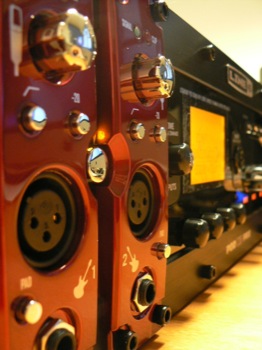 |
Line 6 has managed to improve the POD by adding more models and making it even more complete. The sound quality is good and the number of inputs and outputs makes the POD X3 Pro ready for all situations, in fact it’s hard to find a situation where it wouldn’t suffice. We commend the new interface and screen that makes navigation and editing easier, and the POD Farm plug-in, which opens up new horizons for home studio guitarists. For around $699, the POD X3 Pro offers a POD, an audio interface rich in connections with microphone preamps, and an amp/effects simulator plug-in. A real must for fans of all-in-one solutions!
[+] The number of models
[+] The sound quality
[+] The number of inputs and outputs
[+] The big backlit LCD screen
[+] The GUI – practical and easily readable
[+] The POD Farm plug-in
[+] USB interface with 8 channels
[-] The look
[-] 3U Rack, the POD has gained weight
[-] Effects chain not completely flexible
[-] Mediocre mic preamps
